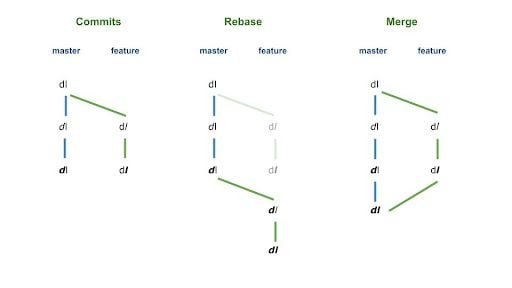Rebasing and merging are both designed to integrate changes from one branch into another branch in Git, but they accomplish this in different ways.
Git Rebase vs. Git Merge Explained
- Git Rebase: Rebasing in Git integrates a change from the base of the feature branch to the master branch’s endpoint. It’s useful for streamlining complex histories.
- Git Merge: Merging takes the contents of the feature branch and integrates it with the master branch. The feature branch stays the same, making it useful for tracking history on complex projects.
For example, let’s say we have a series of commits. The merge will result in a combination of commits, whereas rebase will add all the changes in the feature branch starting from the last commit of the master branch.

What’s the Difference Between Git Rebase and Git Merge?
- When you rebase a feature branch onto a master, you move the base of the feature branch to the master branch’s ending point.
- Merging takes the contents of the feature branch and integrates it with the master branch. As a result, only the master branch is changed. The feature branch history remains the same.
- Merging adds a new commit to your history.
Commits will look like this:

When to Use Git Rebase vs. Git Merge
Rebasing and merging are ideal for different situations. Below are some of the best times for using each:
When to Use Git Merge
- Using a public branch: If the feature branch you are getting changes from is shared with other developers, then you should use merge. Rebasing is not recommended because the rebasing process will create inconsistent repositories.
- Viewing branch history: You should also use merge if you want to see the history as it happened. Merge preserves history, whereas rebase rewrites it.
When to Use Git Rebase
- Working on an individual project: Rebasing makes the most sense for an individual project since it’s useful for streamlining a complex history. You can change the commit history via an interactive rebase, remove undesired commits, squash two or more commits into one and edit the commit message.
- Resolving conflicts one at a time: Rebase will present conflicts one commit at a time, whereas merge will present them all at once. It’s easier to handle the conflicts, but reverting a rebase is more difficult than reverting a merge if there are many conflicts.
Git Rebase and Git Merge Common Mistakes
When applying Git rebase and Git merge, there are several key mistakes to avoid:
Failing to Consult With Team Members
If you’re working with other developers, consult them before deciding to rebase or merge in Git. Changes to public branches affect everyone’s work, so it’s best to get approval beforehand and have team members review your work afterward.
Using Git Rebase on Public Branches
Rebasing should only be done on local branches. Performing a Git rebase on public branches forces anyone using that branch to re-do their work according to the changes. This can create major headaches, especially if it wasn’t communicated to team members beforehand.
Force-Pushing Branches Carelessly
Force-pushing rebases you’ve performed onto a public remote branch effectively overwrites other team members’ work. This can create a confusing situation where users aren’t sure what work is theirs, leading to unnecessary troubleshooting.
Forgetting to Rebase Your Branch Frequently
Developers working as a team often add their own commits and changes to the main branch. If you don’t regularly rebase your local branch against this main branch, it will be difficult to merge your work into the main branch since your branch could become outdated.
Frequently Asked Questions
What does a Git rebase do?
A Git rebase combines or moves a sequence of commits — locations where code is stored — to a main commit, integrating changes from one branch into another branch.
What is Git rebase vs. merge?
Both Git rebase and Git merge are methods for integrating changes from one branch into another branch. The main difference is that rebasing overwrites a branch’s history while merging preserves the history of both branches.
When should I use Git rebase?
Git rebase is well-suited for use on individual projects and is helpful for resolving conflicts one at a time. Attempting to use rebasing on public branches can impact the work of other users, so it’s best to limit rebasing to local branches.
Is rebase risky?
Rebasing in Git can overwrite the history of previous commits on a public branch, so it’s better to avoid using rebase on shared branches. It’s also best practice to frequently rebase any local branches against a main branch to keep your individual branches up-to-date. Otherwise, rebasing an outdated branch against a main branch could result in merge conflicts.





